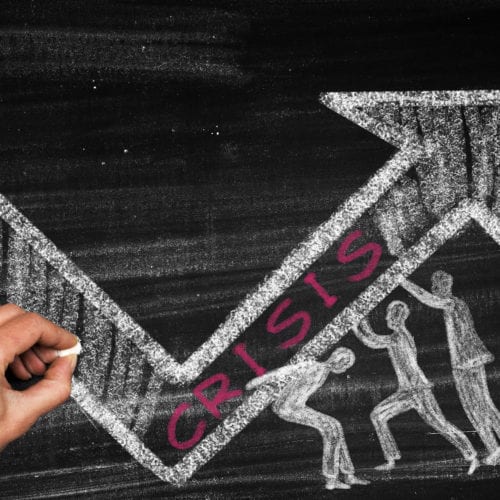Aerial view of crowd connected by lines

COVID-19, Data, and Climate Change
COVID-19 mitigation is a systems problem with many of the same characteristics as the climate fight. While one is fast and the other slow, both underscore the need to create transparent and reliable systems by which people, organizations, and governments at all levels can share and access trusted data to inform lifesaving decisions.
Both the coronavirus pandemic and the climate crisis have been caused by and fought in the context of disparate but interconnected global systems. A disturbance in one system, such as localized outbreaks, can cause cascading failures in others, such as airline employees losing jobs as a result of travel bans. The systems involved in each crisis also are rife with delays in being able to “see” the problem due to lags in data access. They also have critical tipping points that, when crossed, can cause irreversible damage. Lives, communities, and economies are at stake, with poorer populations disproportionately impacted.
The best-case scenario for stopping COVID-19 and preventing the worst effects of climate change is to flatten the curves—both of new infections and atmospheric CO2 concentrations. Neither challenge has a simple solution, and decisions about investing limited time and resources require actionable data from a multitude of sources. A key early lesson for the climate fight is that we must more ambitiously connect data across diverse global systems to make the right investments at the right time.
Start with Outcomes; Identify what Matters
This will not be a simple task. The world is awash with questionable data, gathered for unrelated reasons, in a variety of formats. To catalyze action on global challenges we must identify:
- To whom must the data be accessible and how must it be displayed to drive decisions?
- What critical information is required from each system involved?
- What infrastructure, software, rules, and incentives can support the collection and aggregation of quality data from those systems?
In the case of COVID-19, this data informs decision-making and public trust in terms of both 1) understanding the drivers and causes of the virus’ growth and 2) identifying the solutions and investments that society needs to make. The table below highlights examples where data from each area could help mitigate the COVID-19 and climate crises.
| Data Category | COVID-19 | Climate Change |
|---|---|---|
| Understanding the Problem | ||
| Causes | Where did the virus start? How does it work? | How do emissions impact climate change? |
| Sources | Who has it? How is it being transmitted? | Where are GHG emissions coming from? At what rates? |
| Identification | Which symptoms are common/rare? How can it spread? | What are the CO<sub>2</sub> impacts of the products I use? |
| Impacts | What is the mortality rate? What populations are at greater risk? | How will impacts differ across nations, geographies, class? |
| Identifying Good Solutions | ||
| Adoption | Do quarantines work? What are the economic and social costs? | Which solutions are cost-effective and under what circumstances? |
| Scientific Findings | What have scientists learned that can help in developing a safe vaccine? What treatments might slow its spread? | What technologies can help us decarbonize sectors like steel, cement, and long-distance transport? |
| Behavior Change | What prevents people from taking action for the common good? | Should I change what or the way I consume and how I commute to work? |
| Public investments | Where and how much should we invest in R&D of new solutions? | Where and how much should we invest in R&D of new solutions? |
Make Data Actionable
For data to be actionable, it needs to be accurate, transparent, and standardized. Accurately measuring and tracking carbon emissions has been one of the toughest aspects of international climate negotiations. The current system of monitoring, reporting, and verification that underpins the Paris Agreement relies on self-reported national emissions inventories that lag by more than two years. In the COVID-19 fight, such data lags are inherent in the virus’s up to 14-day incubation period. In the case of carbon emissions, scale, cost, and resolve seem to be the contributing factors.
As COVID-19 cases spread beyond China, the World Health Organization and others pointed out growing inconsistencies in China’s reporting methods that were impacting other nations’ ability to assess risk. Parties quickly aligned on a standardized approach, but not fast enough. Current climate data models suffer severely from inconsistent methodologies, poor alignment around assumptions—such as underestimating new technology adoption—and overall lack of transparency. A crucial opportunity exists for more transparent and standardized approaches that could better inform policy and investment decisions to put us on a path to net-zero emissions by 2050.
Climate Actors Must Align Now on Collaborative Data Solutions
The COVID-19 crisis emerged rapidly, providing seemingly little time to prepare for the critical data tracking and analysis that governments, hospitals, and other first responders needed to make effective decisions. Others, however, have pointed out that the risks, probability, and impacts of such events lie in plain sight. With climate change, there is little doubt that we must take unprecedented steps to avert a more severe crisis. While the impacts may play out over decades rather than days and weeks, the human suffering and economic destruction will far surpass what we’re experiencing today.
This raises the question of who should act. International government-led action has been insufficient in coordinating timely interventions on climate change. In the absence of such leadership, networks of non-state actors (e.g., NGOs and corporations) may be better positioned to create borderless solutions to such global systems challenges. Coalitions of such actors have demonstrated the ability to create vital collaborations that engage industries, supply chains, and people to measure what matters. The Marine Stewardship Council presents one strong example wherein organizations built a robust data-driven ecosystem for sustainable fisheries.
Numerous climate data initiatives have emerged with the right intent, but thus far efforts remain fragmented, lacking consistent methodologies, detail, and inclusion strategies. Recent efforts like the Coalition on Materials Emissions Transparency (COMET), ClimateWatch, WattTime, and the Task Force on Climate-Related Financial Disclosures (TCFD) are raising the level of ambition, but similar efforts are needed in other sectors. The ultimate prize, identified in RMI’s report Seven Challenges for Energy Transformation, is an integrated, open-source system capable of generating global emissions maps with continuously improving granularity, reduced uncertainty, and better real-time data. Even in the midst of the COVID-19 crisis, RMI and other partners are working with increased energy and focus toward this common goal. Please do not hesitate to contact us at es@rmi.org to join us in this essential work.

